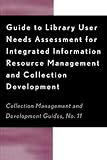Guide to library user needs assessment for integrated information resource management and collection development / edited by Dora Biblarz, Stephen Bosch, Chris Sugnet.
Material type: TextLanguage: English Series: Collection management and development guides ; no. 11Publication details: Lanham, Md. : Scarecrow Press, 2001. Description: vii, 70 p. ; 23 cmISBN: 0810841312 (pbk. : alk. paper); 0810841312Subject(s): Collection management (Libraries) | Library use studies | Needs assessmentDDC classification: 025.58 LOC classification: Z687 | .G847 2001Online resources: WorldCat details
TextLanguage: English Series: Collection management and development guides ; no. 11Publication details: Lanham, Md. : Scarecrow Press, 2001. Description: vii, 70 p. ; 23 cmISBN: 0810841312 (pbk. : alk. paper); 0810841312Subject(s): Collection management (Libraries) | Library use studies | Needs assessmentDDC classification: 025.58 LOC classification: Z687 | .G847 2001Online resources: WorldCat details | Item type | Current library | Collection | Call number | Copy number | Status | Date due | Barcode | Item holds |
|---|---|---|---|---|---|---|---|---|
 Text
Text
|
Dr. S. R. Lasker Library, EWU Reserve Section | Non-fiction | 025.58 GUI 2001 (Browse shelf(Opens below)) | C-1 | Not For Loan | 28267 | ||
 Text
Text
|
Dr. S. R. Lasker Library, EWU Circulation Section | Non-fiction | 025.58 GUI 2001 (Browse shelf(Opens below)) | C-2 | Available | 28502 | ||
 Text
Text
|
Dr. S. R. Lasker Library, EWU Circulation Section | Non-fiction | 025.58 GUI 2001 (Browse shelf(Opens below)) | C-3 | Available | 28503 | ||
 Text
Text
|
Dr. S. R. Lasker Library, EWU Circulation Section | Non-fiction | 025.58 GUI 2001 (Browse shelf(Opens below)) | C-4 | Available | 28504 |
Browsing Dr. S. R. Lasker Library, EWU shelves, Shelving location: Reserve Section Close shelf browser (Hides shelf browser)

|

|

|

|

|

|

|
||
| 025.524 INF 2009 Information retrieval : | 025.56 INF 2013 Information literacy & technology / | 025.5677 TOI 2009 Information literacy education : | 025.58 GUI 2001 Guide to library user needs assessment for integrated information resource management and collection development / | 025.6 BRL 2013 Resource sharing in libraries : | 025.62 FRD 2012 Global resource sharing / | 025.62 LIB 2017 Library information and resource sharing : |
Association for Library Collections & Technical Services, a division of the American Library Association."
Includes bibliographical references (p. 61-65).
TOC The reasons for undertaking needs assessment, defining the value of user assessments, and the theory concerning user needs assessment --
The process for developing a needs assessment project --
Establish the goals of the assessment --
Assess available resources --
Establish project scope --
Define the user population --
Review current awareness --
Identify useful information --
Establish a time frame --
Complete the plan --
What can be measured and how to measure it: Types of assessment data that may be useful --
Direct user input (e.g., user surveys) --
Pros and cons of direct user input for needs assessment --
Methodology for direct user input --
Exploratory data collection --
Focus groups --
Qualitative input from surveys --
Crucial incident surveys --
Internal staff feedback --
User interviews --
Representative data gathering --
Techniques for random surveys --
Direct mailing --
Online forms --
Randomly timed surveys --
Secondary information: Data that describes current conditions --
Specific types of secondary data --
Demographic data --
Specific demographic data for academic libraries --
Specific demographic data for public libraries --
Number and distribution of student enrollment credit hours --
Course offerings --
Electronic resources use statistics --
Circulation statistics --
Circulation patterns of monographic/serial collections --
Statistics derived from patron requests for holds/recalls on currently circulating materials --
In-house use statistics for both serials and monographs --
Photocopy activity.
This volume examines the practice, benefits, and specific methods for assessing library users' information needs in any type of library. This needs assessment can be defined as the process of using one or more techniques to collect and analyze data regarding library users or potential users.
DIS
Sagar Shahanawaz

There are no comments on this title.